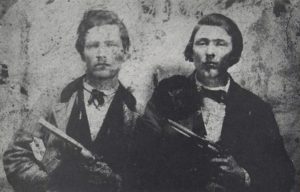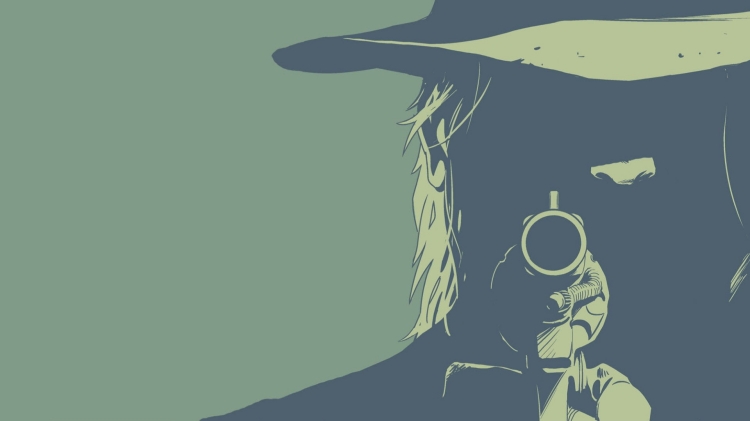The myth of the Old West exerts a tremendous influence on the popular imagination. Zane Grey pulp novels, countless TV series, and iconic Western films ensure that the cowboy remains a uniquely American archetype representing in one writer’s words, “movement, isolation, change, and new beginnings.” Of course, the outlaw is an essential trope in this narrative of fierce independence, surly rebelliousness, and flagrant disregard for the law. Who of us doesn’t admire, if begrudgingly, the swagger of Billy the Kid, the daring of the James brothers, Frank and Jesse, the cagey resourcefulness of Butch Cassidy, the Sundance Kid, and the Hole in the Wall Gang? The American myth would be incomplete without these antiheroes of the nineteenth century frontier.

However, what many people may not know is that Old West outlaws often had their origins in other parts of the country, often returning “home” for a time to escape capture by lawmen in pursuit of them. Jesse and Frank James, for example, took occasional sabbaticals from bank and train robbing, traveling to East Tennessee, and seeking refuge in the Old Washington community in Rhea County. A new locale didn’t hinder the James brothers from practicing their trade. A man I knew in the 1980s, named Henry Hunter, 92-years-old at the time, regaled me with a story about how the Jameses robbed his grandfather at gunpoint following a horse auction. By that time, the brothers’ exploits were legendary. They’d earlier gained notoriety as members of Quantrill’s Raiders, a small group of pro-Confederate guerillas who harassed Union soldiers along the Kansas-Missouri border during the Civil War. Under the direction of their leader, William Clarke Quantrill, the ragtag raiders perfected military tactics, including disguises, coordinated and synchronized attacks, planned dispersal after an attack that used preplanned routes and relays of horses, and use of multiple .36-cal. Colt revolvers for increased firepower and improved accuracy of the .44-cal. After the war, the duo used these hit-and-run ploys to further their careers as outlaws.
Another Old West outlaw with ties to Appalachia, and specifically to Knoxville, Tennessee, was Harvey “Kid Curry” Logan. Once a sidekick of Butch Cassidy and the Sundance Kid, Kid Curry was, in the words of detective and bounty hunter William Pinkerton, “the only criminal I know of who has not one single redeeming feature.” According to Knoxville journalist Chuck Allen, the Kid earned his reputation as a gunslinger for killing nine law enforcement officers in five separate shootouts, not to mention two civilians in other circumstances. He likely came to Knoxville in the summer of 1901 to lie low in the aftermath of a $40,000 heist that he and cronies staged, robbing the Great Northern Express near Wagner, Montana. In Knoxville, Logan changed his name to William Wilson and began to court a woman named Laura Cross whom he intended to marry. Curry’s plan blew up on the evening of December 13, 1901, when the Knoxville Police Department responded to a call at Ike’s Knoxville Saloon at the corner of Central Avenue and Commerce Street. Expecting to find a bar fight, or some other minor disturbance, police instead found Kid Curry who opened fire, wounding two officers seriously before escaping out the rear of the establishment. Two days later, law enforcement captured him in Jefferson City. Curry remained in the Knox County jail for a year and a half, becoming a celebrity in the process as hundreds of locals filed through the jail to get a glimpse of him. In 1903, in a daring move worthy of a movie, Curry choked a guard with a wire, escaping the jail never to be seen in Knoxville again.
While Southern Appalachia and its mountains often proved a safe haven for Old West Outlaws, our own homegrown villains could be just as ornery and dangerous, as the following rogues’ gallery reveals:
-
-
- Harpe Brothers – In 1799, the Governor of Kentucky offered a reward for the capture of either or both of the Harpes – Micajah “Big” Harpe and Wiley “Little” Harpe, accused of killings in southern Illinois, East Tennessee, and Kentucky. Victims included their own children. Believing that Little Harpe’s crying baby would someday be the means that posses would detect their presence, Big Harpe slung the baby by the heels against a tree, bursting the infant’s head open. In their first year as outlaws, they murdered 20 people, inspiring terror in residents throughout Tennessee and Kentucky. No one knew when the Harpes would show up day or night during one of their numerous killing sprees. On the night of August 20, 1799, the pair reached the house of Moses Stegall, seeking shelter. Moses wasn’t at home, but his wife and their four-month infant were, along with a surveyor, named Major William Love, who had business with Moses Stegall the next day. Mrs. Stegal fed the three men supper, indicating they could sleep in the loft. When Major Love fell asleep and began snoring, Little Harpe took a hand axe from his belt and dashed the man’s brains out. The Harpes then went to Mrs. Stegall’s bedroom and woke her, complaining that she’d bedded them down with a man snoring so loudly they couldn’t sleep. They then murdered the woman and child and set the house on fire before leaving.
-
On discovery of the charred bodies, Squire Silas McBee and five men awaited Moses Stegall’s return. When Moses rode up, Squire McBee related the circumstances of the deaths of Stegall’s wife and child. A hunt for the Harpes ensued. A posse of seven men found their trail and followed it until night. The next morning, they spotted the Harpes after riding only a few miles. Big Harpe dashed off on his horse, his pursuers giving chase and firing shots at the outlaw until a bullet found its mark. Harpe slowed and was captured, forced to stand face-to-face with Moses Stegall who brandished a knife in one hand and a gun in the other, pointed at Big’s face. Stegall threatened to shoot the outlaw in the head but through better of it, saying, “I will not shoot you in the head for I want to make a trophy of it.” Shooting Big Harpe in the heart instead, Moses cut off Big’s head, tossed it in a sack, and rode to a crossroads where he placed the grim trophy in the fork of a tree as a warning to others.
-
-
- Champ Ferguson was a notorious Confederate guerilla during the Civil War. He’s alleged to have killed over 100 Yankee soldiers and pro-Union civilians. Born in Clinton County, Kentucky, on the Tennessee border, Ferguson was the oldest of ten children. He earned a reputation for violence even before the Civil War. On August 12, 1858, an altercation would result in a feud between Ferguson and the Evans brothers, Floyd and Alexander. Ferguson repeatedly stabbed to death the Evans’ cousin, James Reed, acting constable of Fentress County, Tennessee.
-
Early in the war, Ferguson organized a guerilla unit and began to attack civilians whom he believed to be Union sympathizers. Stories circulated about Ferguson’s sadism, alleging tales that he sometimes decapitated his prisoners, rolling their heads down hills. He was said to murder elderly and bedridden men, too. Ferguson was hanged by military personnel on October 20, 1865, and is buried in White County, Tennessee, north of Sparta.
Trying to find women outlaws in 19th century Appalachia produced few results. If women murdered their mountain husbands, they didn’t confess and likely resorted to poison. There’s a saying here that expresses the consensus about a wife killing a husband: “If the son of a bitch hadn’t deserved it, she wouldn’t have killed him.” That sentiment, coupled with the resourcefulness of Appalachian women and granny women throughout the region, may be all the reason needed to explain the dearth of women outlaws in Appalachia.
A more certain circumstance is that mountain women were too often victims of violence, and worse, at the hands of their menfolk. So common were these occurrences that there arose a genre of songs known as “Appalachian Murdered Girl Ballads.” According to Ariadne Blayde, “
The Murdered Girl Ballad originated in the British Isles with such traditional ballads as ‘Lady Isabel and the Elf-Knight’ and the ‘Cruel Ship’s Carpenter.’ These ballads were brought overseas by the Scots-Irish who settled the Appalachian region in the 1700s and were gradually adapted to fit a more Americanized worldview and a uniquely Appalachian mode of experience.
Blayde lists the standard narrative components of a Murdered Girl Ballad:
- Woman loves man and man loves (or pretends to love) woman.
- Man leads woman on a walk or a ride into the wilderness.
- Man tells woman he is going to kill her.
- Woman begs for her life.
- Man murders woman by drowning, stabbing, or clubbing her.
- Man disposes of woman’s body and flees.
- Man is caught.
- Man confesses and is punished.
-
 Dolly Parton - "Banks of the Ohio"
Dolly Parton - "Banks of the Ohio" -
 James Findlay - "Long Lamkin"
James Findlay - "Long Lamkin" -
 Wyclef Jean - "Delia's Gone"
Wyclef Jean - "Delia's Gone" -
 Frank Proffitt - "Tom Dooley"
Frank Proffitt - "Tom Dooley" -
 Vandaveer - "Pretty Polly" (Official Video)
Vandaveer - "Pretty Polly" (Official Video) -
 Jimmy Martin - "Poor Ellen Smith"
Jimmy Martin - "Poor Ellen Smith" -
 Scruffy City All-Stars - "Knoxville Girl"
Scruffy City All-Stars - "Knoxville Girl" -
 Tracy Bonham - "In the Pines"
Tracy Bonham - "In the Pines" -
 Tim O'Brien - "Down in the Willow Garden"
Tim O'Brien - "Down in the Willow Garden"
Appalachia is a region distinguished by its uniqueness. Why would its outlaws be any different? If you’ve enjoyed this post, leave a comment. At Appalachia Bare, we strive to be, hands-down, the region’s best blog on Appalachian history, literature, and culture. As always, we appreciate your support.
For further reading about these outlaws:
-
-
- “Kid Curry Takes On the Knoxville Department.” Chuck Allen. The Knoxford Files. June 11, 2009.
- “This Murder Done: Misogyny, Femicide, and Modernity in 19th Century Appalachia Murder Ballads.” Christina Ruth Hastie. Master’s Thesis. University of Tennessee. 2011.
- “Harpe Brothers.” Wikipedia.
- “The Harpes – Two Outlaws of Pioneer Times.” Dave Tabler. Appalachian History: Stories, Quotes, and Anecdotes. April 11, 2019.
- “The Devil in Appalachia: The Bloodthirsty Harpe Brothers“
-
























Wonderful pictures and history well writte in another of your masterpieces, Professor!
Thank you, Barbara! So glad you enjoyed.
This macabre and colorful piece was a hoot and a history lesson – nice work!
Jimmy, many thanks! I always appreciate your comments.